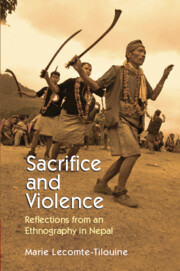Book contents
- Frontmatter
- Contents
- List of map and figures
- Note on transliteration
- Acknowledgements
- Map
- Introduction
- 1 A violence that is not violence
- 2 Theories of sacrifice, with or without violence
- 3 Sacrificial violence in narrative forms
- 4 Sacrificial practices and partitions
- 5 The buffalo sacrifice
- 6 Contestations of sacrifice: boycott and litigation
- 7 Self-sacrifice versus sacrifice in the revolutionary struggle
- Conclusion
- References
- Index
3 - Sacrificial violence in narrative forms
Published online by Cambridge University Press: 28 November 2024
- Frontmatter
- Contents
- List of map and figures
- Note on transliteration
- Acknowledgements
- Map
- Introduction
- 1 A violence that is not violence
- 2 Theories of sacrifice, with or without violence
- 3 Sacrificial violence in narrative forms
- 4 Sacrificial practices and partitions
- 5 The buffalo sacrifice
- 6 Contestations of sacrifice: boycott and litigation
- 7 Self-sacrifice versus sacrifice in the revolutionary struggle
- Conclusion
- References
- Index
Summary
The buffalo sacrifice is closely related to myth. It brings into being the Goddess's combat as described in her Celebration, the Caṇḍī pāṭh, and a recitation of the text is incorporated into the liturgy of the ritual. In its dual role as both a model for and an integral part of the sacrificial rite, the myth is doubly brought to life. Does it narrate the unfolding of the action? Or is it simply enough to read its contents in order to shed light on all the different aspects of the ritual? The answers to these questions will be proffered in the next chapter, which is devoted to a detailed description of the ten days of Dasaĩ, where the Celebration of the Goddess is conducted, as both a narrative and a sacrifice, during a holistic rite in which the organisational structure of society and the power of the chiefs are renewed. The rite therefore goes beyond the combat that it plays out, and summons other mythical models, models which present caste society and royalty as being the products of sacrifice. This broader framework must first be sketched out, without undertaking a textual analysis, but by considering how the myth manifests itself in everyday life in Nepal, in allusions or short stories, which form so many threads in the tapestry of the world which makes up ‘Brahmanic teaching’.
The recitation of the text by the Brahmin carries the same term, pāṭh, as that used for pedagogical teaching. In Nepal, this ‘teaching’ has long passed for a child's basic education, as these words of an old Rai make clear: ‘We did not know as much as today about the outside world. We had heard of Sri Lanka, Ayodhya, Benares and Badrinath from the Puranas. We believed the earth was flat and resting on water, held to the surface by the serpent Shesh Nag.’ In rural areas, it was not until the 1990s that a rationalist movement emerged among the Indigenous peoples, which targeted some of the contradictions and fantasies to be found in Hindu mythology. The movement then turned against the specialists of the myths, the Brahmins, recasting them as educated liars. And the Indigenous peoples reformulated Paul Veyne's famous question3 to ask: ‘Why did the Brahmins make us believe in their myths?’
- Type
- Chapter
- Information
- Sacrifice and ViolenceReflections from an Ethnography in Nepal, pp. 69 - 100Publisher: Cambridge University PressPrint publication year: 2024

